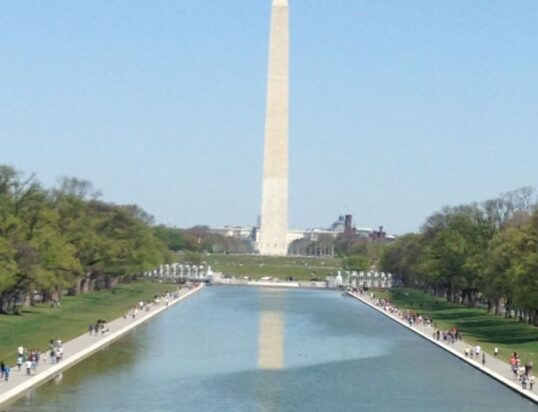My husband and I toured Washington D.C. in the spring of 2016 along with a group of forty other people. Our tour guide explained that our index card name tags taped on the wall near our coach seats would rotate. “All will have an equal chance to view the scenery from the choice seats,” she said. “It’s the democratic way.”
The first day of our five-day tour we boarded the bus for Arlington Cemetery. Two elderly women who kept to themselves sat in the front seat. The coach drove slowly, and we viewed acres of flowering apple and cherry trees mixed with colorful tulips. These stood in sharp contrast to the rows of small white gravestones denoting sacrifices fellow Americans—heroes—had made for our freedom.
The next day the two elderly women again sat in the front seat. If they’d switched name tags, the message of democracy obviously wasn’t sinking in. A group of us whispered about our suspicions.
The women were both well-dressed, and I assumed they were either sisters or friends. I’d attempted conversation with one of them earlier, but didn’t get much of a response. They continued to ignore the rest of us.
Our group split into interest groups, and I chose to tour a museum exhibit of self-taught artist Clementine Hunter. The daughter of slaves, Clementine picked cotton in Louisiana. During any free time, she painted scenes of life on a plantation. Her work overflowed with life, hardship, and in a few cases joy. Her passion and desire to share her art talent allowed me to get a sense of what her life was like back then.
On the third day several of us caught one of the elderly women moving her and her friend’s name tags to the front. Knowing we were observing her, she set her jaw in an arrogant manner as if defying us to speak out. Was it worth the trouble to confront her? We remained silent.
While viewing the Cherry Festival Parade, we stood while a uniformed general on horseback carried the American flag. The horse deposited a messy pile. A female officer in her spotless, starched uniform and polished shoes would have to walk through it in order to keep the straight line. A young man yielding a plastic bag rushed out onto the street and scooped up the manure. His swift action left an impression on me. Heroic deeds, I reflected, both large and small, are performed every day.
The memorials to Thomas Jefferson, Franklin Roosevelt, Martin Luther King, the Marine
Corps and the Korean War moved me to tears. With a catch in my throat, I visited with a man on our tour. A retired police officer, he mentioned that he’d been on duty at the World Trade Center during the September 11th terrorist attack. He looked away, his eyes letting me know he didn’t want to talk about it. I could only imagine all he’d seen and done.
On the fourth day of our tour, our guide noticed that the elderly women were once again in the front seat. “What’s going on here?” she asked.
The retired police officer told her they’d been moving the name tags. Our guide whipped off their index cards and pointed to a seat near the back. When they didn’t go, she said the bus would not move until they did. The women obeyed. Our judicial system at work, I thought, wanting to applaud.
We concluded our tour with a visit to Washington’s Mount Vernon and Jefferson’s Monticello. I was overwhelmed with facts and proof of our founding father’s devotion to our country, but my mind kept flicking back to the police officer who spoke up, to our tour guide who took action, and to the young bystander who ran out in the street to pick up manure so the military wouldn’t have to walk through it. Modern day heroes.
I was left with hope for our future and admiration for the heroes who surround us every day.

